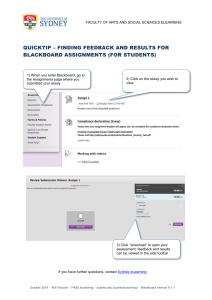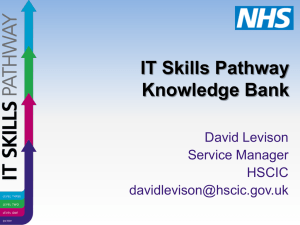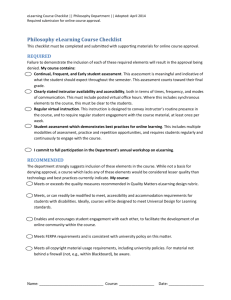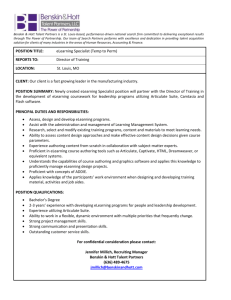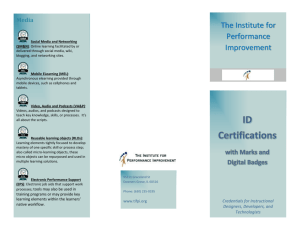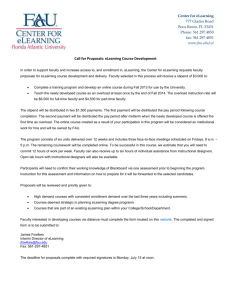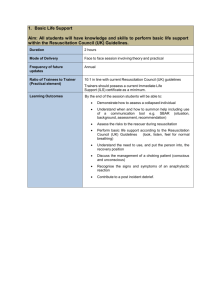Submit an article to the eLearning Papers Journal
advertisement
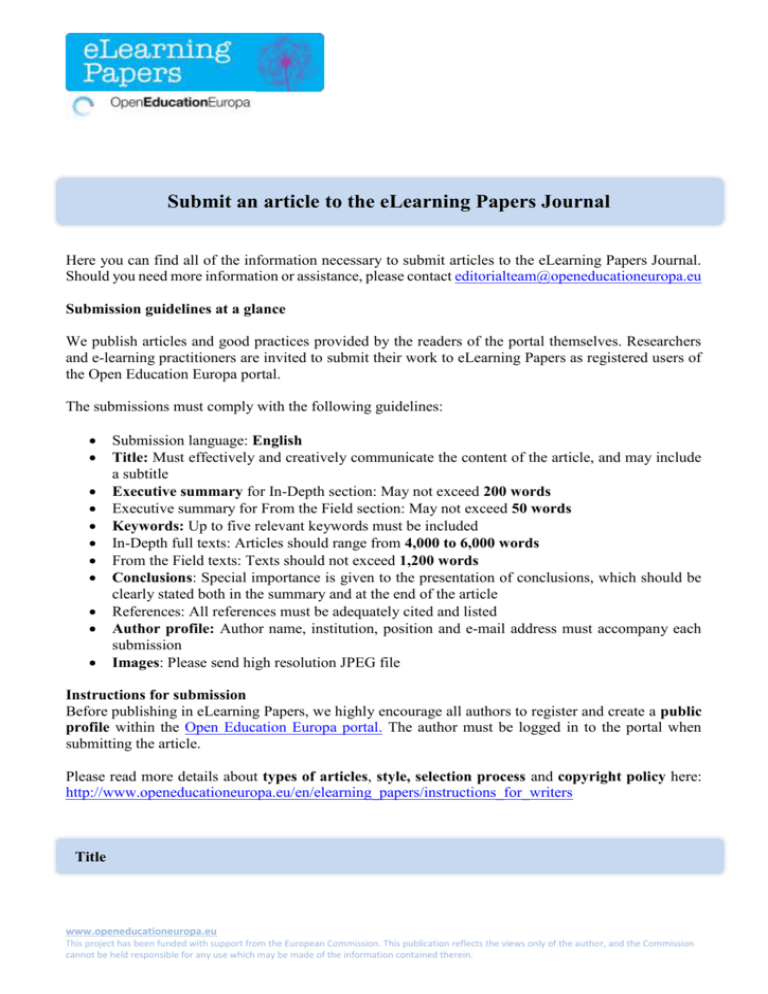
Submit an article to the eLearning Papers Journal Here you can find all of the information necessary to submit articles to the eLearning Papers Journal. Should you need more information or assistance, please contact editorialteam@openeducationeuropa.eu Submission guidelines at a glance We publish articles and good practices provided by the readers of the portal themselves. Researchers and e-learning practitioners are invited to submit their work to eLearning Papers as registered users of the Open Education Europa portal. The submissions must comply with the following guidelines: Submission language: English Title: Must effectively and creatively communicate the content of the article, and may include a subtitle Executive summary for In-Depth section: May not exceed 200 words Executive summary for From the Field section: May not exceed 50 words Keywords: Up to five relevant keywords must be included In-Depth full texts: Articles should range from 4,000 to 6,000 words From the Field texts: Texts should not exceed 1,200 words Conclusions: Special importance is given to the presentation of conclusions, which should be clearly stated both in the summary and at the end of the article References: All references must be adequately cited and listed Author profile: Author name, institution, position and e-mail address must accompany each submission Images: Please send high resolution JPEG file Instructions for submission Before publishing in eLearning Papers, we highly encourage all authors to register and create a public profile within the Open Education Europa portal. The author must be logged in to the portal when submitting the article. Please read more details about types of articles, style, selection process and copyright policy here: http://www.openeducationeuropa.eu/en/elearning_papers/instructions_for_writers Title www.openeducationeuropa.eu This project has been funded with support from the European Commission. This publication reflects the views only of the author, and the Commission cannot be held responsible for any use which may be made of the information contained therein. STUDENT'S QUALITY PERCEPTION AND LEARNING OUTCOMES WHEN USING AN OPEN ACESSIBLE ELEARNING-RESOURCE Author(s) Bissinger, Kerstin University of Bayreuth, Didactics of Biology Department Researcher, PhD student Kerstin.Bissinger@uni-bayreuth.de Bayreuth, Germany Bogner Franz X. University of Bayreuth, Didactics of Biology Department Professor, head of department Bayreuth, Germany Keywords Quality of OERs; student’s perception; learning outcome; rainforest; climate change Abstract / Summary The present study focuses on 10th graders’ perceptions of open educational resources (OERs) by examining students’ rating of one exemplary open educational resource. Individual cognitive load while working on the web-based module was monitored. Additionally, we focus on learning outcomes monitored in a pre- and post-test deign using questionnaire as well as digital workbooks. The completion of one exemplary task depicts the potential to foster critical thinking by using OERs. Using these different aspects permit us to evaluate the quality of the used OER from a student’s point of view. In summary our results points to a positive perception of the used OER, a cognitive achievement effect as well as the potential to support critical thinking which altogether supports a good quality of the resource and supports our strategy to be successful in order to assess quality of OERs in general. Body 1. INTRODUCTION eLearning is regarded as a “new learning paradigm” (Yacob et al. 2012; Sun et al. 2008) and consequently enters more and more into today’s education. These circumstances are reflected in the Digital Agenda for Europe, where especially Action 68 requests to “mainstream eLearning in national curricular for the modernisation of education”. Consequently, requirements for digital literacy of educators and students lead to the establishment of initiatives like Open Education Europa or the Open www.openeducationeuropa.eu This project has been funded with support from the European Commission. This publication reflects the views only of the author, and the Commission cannot be held responsible for any use which may be made of the information contained therein. Discovery Space Project (ODS). Both projects share an important word in their title: “Open”. Open can refer to different aspects like education should be open to everyone, or everyone should be allowed to contribute to education regardless of place, time or social aspects. In this sense open refers to an additional aspect: “Open educational resources” (OERs) which means digitally available resources for everyone. The idea is to motivate teachers to share their ideas across boundaries and work together in order to promote a literate and responsible next generation of European citizens. Consequently the main objective of ODS is to introduce changes in educational practices and develop resource-based learning. As a starting point, pedagogical best practice scenarios were developed and uploaded to a digital access point: the ODS portal. So far 6092 teachers are connected within 395 communities and have access to 721916 resources. The evaluation of ODS mainly addresses teachers by monitoring their actions on the portal and the implementation of questionnaires during workshops, coupled with more qualitative direct evaluation through workshops, interviews and focus groups (Bissinger et al. 2014). However, the OERs within the teacher communities of the different projects are providing the basis for collaboration and learning and thus their quality plays an important role for the sustainable implementation of open education and learning. Yet, defining quality in regard to eLearning and OERs is one of the “central challenges for theory and practice” (Ehlers, 2004). In order to define quality in this context Dondi (2009) suggests to “consider the influence and visions of stakeholders on quality perception”. Besides encouraging teachers to actively engage in OER-communities by using, adapting and creating digital resources, students are an important stakeholder group as well. They are the actual end-user presumably profiting the most by the integration of innovative learning methods leading to computational literacy and the fostering of 21st century skills. Consequently, it is important to examine how students are affected by and perceive OERs as “quality seems to be in the eye of the beholder” (Dondi 2009). Even within one stakeholder group, differences concerning quality perception emerge (Boonen 2005 cited in Dondi 2009) making the assessment of quality difficult. These difficulties have led to some complains about a lack of documentation for eLearning as an “effective delivery mechanism” with respect for instance to learning outcomes (Manochehr, 2006). Up to now, there are some results existing in regard to students’ perception of eLearning and the related learning outcomes: Morgil et al. (2004) found students as pre-set to acquire knowledge „through the teacher“ and consequently as hesitant to use computer assisted educational applications; nevertheless, this perception changed after participating in an eLearning class. Cox (2013) reported students’ attitudes being dependent “upon their overall experience of using e-learning“. In regard to quality perception Ehlers (2004) described four groups of quality perception from a learner’s perspective which differ based on their preferences. Our present study focuses on the implementation of an exemplary OER which is publicly available on the ODS portal: Tropical Rainforest and Climate Change. The OER tackles a complex thematic area which is imparted through eLearning in order to help students in a suitable manner to understand the role of tropical rainforest in the context of climate change and to establish their own opinions on this media-influenced topic. Starting from a basic exploration of the ecosystem, students analyse original data from Ecuador in order to find an informative basis to detect climate change. They also calculate their own carbon footprint and become acquainted with various actions which can be implemented in www.openeducationeuropa.eu This project has been funded with support from the European Commission. This publication reflects the views only of the author, and the Commission cannot be held responsible for any use which may be made of the information contained therein. their daily life in order to tackle climate change. All these aspects aim to foster education for a sustainable development. Therefore it was officially awarded to become a contribution to the UN decade of sustainable development. This learning resource was viewed by 59 different teachers of the ODS portal since its launch in June 2014 and was rated with 5 out of 5 stars by them. The current study presents the quality perception of students reflected by their rating of tasks in regard to their cognitive load (CL; Paas & Van Merriënboer, 1994) and perception of usefulness. Additionally we focus on their cognitive achievements which provides an external quality criteria. We reflect our results taking into account student’s computer user self efficacy (CUSE; Cassidy & Eachus, 2002). 2. MATERIAL AND METHODS 114 tenth graders (age 16.51; SD 1.459; 50.88% male, 49.12% female) participated in a 1.5 hour learning programme dealing with tropical rainforest and climate change. Students followed the learning scenario available on the ODS portal and worked with the OER “Bayreuth goes Ecuador” which is a website compromising several applications like a video, texts, an interactive animation, a carbon footprint calculator and an analysing tool to examine two original datasets of an interdisciplinary research group recorded in Ecuador. Students are guided through these activities by dividing the unit into three different tasks including five leading questions each of which they directly answer on the website (and send themselves via email) or in a digital workbook. In order to analyse students’ quality perceptions concerning this learning scenario, the participants were asked to rate how appealing they found the three different. School grades were used for this purpose as students are familiar with this scale ranging from 1 “pleased me very much (well done)” to 6 “pleased me not at all (insufficient)”. Additionally, we asked students to state their CL varying between 1 very small CL and 9 very high CL with 5 as an anchor point defined as the CL of an everyday class. 82 students provided their opinion on these variables. Measuring learning outcomes was based on a pre-, post-test design (Figure 1). All tests contained 30 questions dealing with tropical rainforests and climate change, which were covered by the eLearning programme and a previous preparing hands-on circle. In order to consider different preferences in regard to computer usage the post-questionnaire contained the 30 item comprising CUSE scale (Cassidy & Eachus 2002) which asks student’s self-assessment. Students rate statements concerning typical computer implementations, problems or fears on a scale www.openeducationeuropa.eu This project has been funded with support from the European Commission. This publication reflects the views only of the author, and the Commission cannot be held responsible for any use which may be made of the information contained therein. ranging from 1 (strongly disagree) to 6 (strongly agree) for each item. All 114 students answered these questionnaires. Figure 1: Study design Furthermore, the digital workbooks of these 114 students were analysed regarding two exemplary tasks. Task A contains the shading of tropical rainforest regions on a map (example provided in Figure 3), while task B focussed on the analysis of original data and asked students to draw their own conclusions concerning the existence of a temperature trend, its causes and consequences. The latter task was analysed according to Mayring’s qualitative content analysis (Mayring, 2004), and statistical analysis was performed using SPSS Version 22 (IBM Coorp. 2013). 3. RESULTS In general, students rated all three tasks within the fair ranges (means between 2.46 to 2.74) although some of them required the total spectrum for feedback. This is reflected by written comments (in the digital workbooks) like “It was interesting and was fun.” (male student, age 14), “...all [other] tasks were ok” (male student, age 15), “really helpful, recommendable” (male student, age 16). Some students stated the tasks were “complex to handle...” (female student, age 17) which points to a CL situation. Herein, the complete range was needed in order to rate the tasks. Generally, students rated all tasks below the CL of a usual lesson in their classes. Figure 2: students’ perception of eLearning illustrates our finding showing boxplots of the ratings and the stated cognitive load . In regard to student’ CUSE values we found a rather self-confident group of students with CUSE mean values ranging between 3 and 6 with a mean of 4,44 (SD=.704). www.openeducationeuropa.eu This project has been funded with support from the European Commission. This publication reflects the views only of the author, and the Commission cannot be held responsible for any use which may be made of the information contained therein. Figure 2: students’ perception of eLearning The Kolmogorow Smirnow test yields non-normality for all variables (age, grades, CL, gender, CUSE mean; p < 0.001). Consequently, non-parametric analyses were used for examining further interrelations. There is no connection between gender and the perception of the OER (neither grades nor CL), which is supported by a non-significant Mann-Witney U and Wilcoxon Test using gender as grouping variable (Table 1). Additionally the computer user self efficacy of male and female students does not differ significantly (Mann Whitney U test (U=.332; p=.05). The provided grades and the CL of each task correlate positively (marked bold in Table 2). Furthermore, CL also correlates positively between the different tasks, and additionally the grade of the first task correlates positively with the second and third task (Table 2). The computer users’ self efficacy of our students does not show any significant correlations neither with the provided grades nor with the indicated CL or age. Table 1: Gender equality T1_grade T2_grade T3_grade Mann-Whitney-U-Test 768.500 702.000 719.500 Wilcoxon-W 1363.500 1297.000 1895.500 U -,483 -1,131 -,983 Asymp. Sig. (2-tailed) .629 .258 .326 T1_CL T2_CL T3_CL Mann-Whitney-U-Test 794.500 657.500 763.5 Wilcoxon-W 1970.500 1833.500 1939.500 U -.206 -1.511 -.502 www.openeducationeuropa.eu This project has been funded with support from the European Commission. This publication reflects the views only of the author, and the Commission cannot be held responsible for any use which may be made of the information contained therein. Asymp. Sig. (2-tailed) .837 .131 .616 In regard to student’s learning outcomes, all 30 items showed a Cronbach’s alpha of 0.77 and thus can be used reliably. Students generally improved their knowledge by using the eLearning resource. The maximal knowledge increase constitutes 11 items whereas the mean is 3.16 items with a standard deviation of 2.45 items. No gender effect was observed (Mann Whitney U test: U=-1.562, p=0.118). No significant correlation between age and knowledge gain occurred (Spearman Rho=-0.114; p=0.229). Concerning Task A, 4.17 correct regions (SD=2.04) were averagely shaded in the pre-test. After participating in the scenario students correctly shaded almost two new regions during the post-test (mean 1.96 SD 1.828) depicting a significant (p<0,001) knowledge increase. Figure 3: Shading tropical rainforest regions Table 1: Spearman Correlations T1_ Age grade Age R 1.000 Sig. T1_grade R Sig. T1_CL T2_ grade T2_CL T3_ grade T3_CL CUSE .034 -.088 -.053 .052 -.006 -.035 .156 .762 .434 .638 .642 .960 .753 .161 1.000 .272* .414** -.028 .240* .020 .131 .013 .000 .800 .030 .858 .241 www.openeducationeuropa.eu This project has been funded with support from the European Commission. This publication reflects the views only of the author, and the Commission cannot be held responsible for any use which may be made of the information contained therein. T1_CL .090 .361** .054 .495** -.019 .423 .001 .631 .000 .864 1.000 .228* .211 .136 -.018 Sig. .039 .057 .222 .873 R 1.000 .114 .345** .036 .308 .001 .725 1.000 .367** -.039 Sig. .001 .725 R 1.000 -.144 R 1.000 Sig. T2_grade R T2_CL Sig. T3_grade R T3_CL Sig. .198 R 1.000 CUSE Sig. * Correlation significant (two-tailed) at 0.05 level. **Correlation significant (two-tailed) at 0.01 level. The majority of students correctly recognized a raising temperature trend in the research data of task B, whereas only 7% did not report a trend. Additionally, some students assessed the quality of this temperature increase: 4% regarded the increase as huge over time, while 6% stated the increase as very [%] small (shown in Figure www.openeducationeuropa.eu This project has been funded with support from the European Commission. This publication reflects the views only of the author, and the Commission cannot be held responsible for any use which may be made of the information contained therein. FIGURE 4). While reflecting on the reasons for this temperature trend, students provided four concepts: global climate change, the anthropogenic greenhouse effect, human land use and generally the loss of the tropical CO2-repository. Hereby the two rather „general global reasons“ climate change and greenhouse effect were mentioned dominantly which is shown in Figure 5ERROR! REFERENCE SOURCE NOT FOUND.. A similar pattern can be found by examining the consequences which students suggested. Here as well, global consequences like “melting of poles”, “changing of seasons” or “sea level rise” were mentioned often although students were explicitly asked to describe consequences for the tropical rainforest ecosystem. The distribution of consequences is shown in Figure 6. About 50% of the students focussed on the actual task and described consequences for the tropical ecosystem. [%] Figure 4: Students’ statement on temperature trends [%] Figure 5: Reasons for temperature increase www.openeducationeuropa.eu This project has been funded with support from the European Commission. This publication reflects the views only of the author, and the Commission cannot be held responsible for any use which may be made of the information contained therein. [%] Figure 6: Consequences in tropical rainforest ecosystem More than half of these students mentioned the loss of biodiversity whereas 10% described the disturbance of the ecosystem including all connected biological consequences (adaptation, migration, speciation and extinction). The loss of lebensraum (mainly for animals) was also described 10% of our participants. 4. DISCUSSION We found a general positive perception for the implemented eLearning scenario “Tropical Rainforest and Climate Change”. This possibly resembles students’ familiarity and comfort with modern pedagogical practice. Even at home technology is familiar and widespread: 85% of German households own a personal computer and 93% of people aged 16-24 years use the internet daily1. However, not all students rated the tasks as pleasant which is reflected through the utilisation of the complete spectrum of grades. This varying perception of students is in line with Cox (2013) who described students’ attitudes as being related to their prior experiences, which are individual and thus probably differing within our sample. However, computer users self efficacy fails as a predictor for different perceptions: we detected no significant correlations between CUSE values and any other variable. However our sample size was perhaps inadequate and the self efficacy of our students was rather high. Interestingly we found no gender effects concerning the CUSE values which contradicts the findings of the original study where Cassidy & Eachus (2002) found significantly higher CSE values for male students. A possible reason for these findings is the development of an information and communication technology (ICT) culture. Since the first study more than a decade has passed and students’ familiarity with ICT has risen and programmes to foster ICT skills especially for females were launched within schools and beyond. These efforts probably closed the gap between male and female students. The federal statistical office reports no significant differences concerning gender to be existent for age groups below 45 years2. So perhaps other factors, like interest or motivation resulting from prior experiences might be more suitable predictor for varying perceptions and thus could be taken into account in future studies. Parker (2004) divides quality into three categories: “learning source, learning process and learning context”. 1 2 Number provided by the federal statistical office federal statistical office www.openeducationeuropa.eu This project has been funded with support from the European Commission. This publication reflects the views only of the author, and the Commission cannot be held responsible for any use which may be made of the information contained therein. In our study we might use these categories to explain the quality of our OER. The “learning source” which refers to the learning materials e.g. our website “Bayreuth goes Ecuador”, the infrastructure teaching and support can be assessed by the grades provided by the students. The quality of the “learning processes” can be reflected by the cognitive load of our students as it is a measure of the cognitive processes which takes place. The adequacy of the “learning context” (the environment in which learning takes place) could be compared to the CUSE values which were stated by the participants. Taking these different dimensions into account we receive a subjective quality perception of our stakeholders. Summarising our results we tend to assess our OER as being of good quality reflected by good grades, a low to medium cognitive load and a rather medium to high CUSE value. When examining the interrelations of task grades a significant correlation between the first task and the rating of the subsequent tasks was found. This could be interpreted as a loss of motivation. If students did not like the first task (high = bad mark), they did not like the others either. This might reflect a general problem with the learning method as described below. Sun et al. (2008) found seven variables as determining an eLearners’ satisfaction namely “learner computer anxiety, instructor attitude toward e-Learning, e-Learning course flexibility, course quality, perceived usefulness, perceived ease of use, and diversity in assessment”. Consequently, these aspects need to be taken into account for the ongoing study. Another crucial factor is the correlation between student’s rating and CL. Although CL was found to be below a typical classroom experience, we found a positive correlation between CL and grade. As in the German school rating system a high grade reflects a bad mark we find students perceiving the task as difficult are rating it badly. Furthermore, the correlation pinpoints a relation between the CL of the first and other tasks. If students had difficulties with the first task, they are expected to encounter difficulties with the other tasks as well. This needs consideration as a general difficulty with the learning object and thus the media internet and digital workbook. As the webpage contains a variety of interactive information sources, these findings are in accordance with Van Merriënboer and Ayres (2005) who concluded “element interactivity [...] may be too high to allow for efficient learning. These interrelations create different types of perceptions and thus it is not contradictory that students used the whole spectrum to state their opinion on our OER which is in line with Boonen (2005 cited in Dondi 2009) as explained above. Concerning quality these findings lead to different target groups within our stakeholders who have different quality preferences and thus rated accordingly. Ehlers 2004 defined four quality specific target groups: “The Individualist”, “the Result-Oriented“, “the Pragmatic” and “the Avantgardist”. All these groups have different preferences which are of importance for their quality perception and consequently will rate the same OER in a different manner. These preferences derive from different factors, for example learning styles which should consequently be taken into account as in future studies. In order to receive more impartial quality criteria we analysed student’s learning outcomes. Manochehr (2006) found eLearning to be more effective for particular learning styles than for others. In his study students following the “Assimilator and Converger” learning style performed better and thus reached a higher knowledge increase than the other students. In our study, all students achieved a knowledge increase both in the pre and post-test knowledge questionnaire and in the development of shading tropical rainforest regions. We found no relationship neither between gender, age or computer user self efficacy suggesting our eLearning programme to be efficient for the complete target group reflecting a good quality in regard to the learning outcome. Knowledge increase through the implementation of an eLearning module has already been reported by other authors (Morgil et al., 2004; Cradler &Cradler, 2009) even leading to the statement “Online eLearning is an alternative to traditional face-to-face education” (Sun et al., 2008). However, this conclusion should not be drawn too quickly and is not yet broadly agreed on. Clark (2002) explained it www.openeducationeuropa.eu This project has been funded with support from the European Commission. This publication reflects the views only of the author, and the Commission cannot be held responsible for any use which may be made of the information contained therein. is “not the medium that causes learning. Rather it is the design of the lesson itself and the best use of instructional methods that make the difference”. Consequently, further studies are needed to find a broader consensus on this issue especially as European policy makers promote this direction and late adopting teachers need to become assured of this new learning paradigm. Regarding the students’ competencies within our eLearning scenario, a majority was capable of correctly interpreting a plot of more than 40.000 data points. Nevertheless, the answers mostly followed a media-influenced pattern tending to blame global climate change as the ultimate reason. However a smaller group of our participants detaily reflected on reasons for climate change. When stating the greenhouse effect as a reason this group clearly emphasised its anthropogenic origin. Additionally, the concept of land use included statements like “tropical rainforests get deforested for palm oil plantations (for our daily consumer goods) which leads to an increased carbon dioxide emission and thus an increased greenhouse effect” (female student aged 17). These observations are congruent with the statements provided concerning consequences of climate change. Although specially asked to report on consequences affecting the tropical rainforest ecosystem, the vast majority named global consequences as in the following example: “The consequences of the raising temperature are rising sea levels and melting glaciers.” (male student, aged 17). Here as well students with a focus on the actual task provided more elaborated statements on the loss of biodiversity “which we have not even discovered completely and might contain important medical plants or interesting animals” (female aged 18). Statements like these might originate from a general interest on environment or from a preparation lesson within the botanical garden. Future studies should analyse the correlation between environmental attitudes and knowledge conveyed through digital resources: this might help to detect special target groups of learners which could lead to tailored learning experiences and strategies. The loss of lebensraum which was mainly stated in regard to animals depicts a classical phenomenon named “zoochauvinism” (Bozniak, 1994). Students generally neglect plants as living organisms as a result of education in which plants are seldom used as examples and their daily perception of plants that are not moving and do not show the signs of living at a quick glimpse. It is interesting to mention that we could observe students to pick animals in the interactive animation first and seldom examined plants out of their own interest. As students did not necessarily encounter plants in the eLearning module, it is not remarkable to find this common pattern. Interestingly students who pinpointed the disturbance of the ecosystem included all possible biological consequences and thus did not evaluate the temperature development as something bad but more as an ongoing process which conveys evolutionary trade-offs. This interpretation might result from prior class teaching as ecology and thus adaptation and speciation are topics of the 10th grade curriculum. Certainly, it is interesting to see students connecting their already existing prior knowledge with their findings throughout our eLearning scenario. These observations are in line with Manochehr, (2006) and Cradler & Cradler (1999) as both studies emphasize that eLearning promotes critical thinking and the ability to apply learning. 5. CONCLUSION A successful implementation of any open available eLearning scenario needs reflection in regard to quality, significant learning outcomes and the activation of critical thinking in order to promote 21st century skills within the next generation of responsible citizens. Our study points in this direction. Furthermore, in our study students generally perceived an eLearning scenario as a good learning www.openeducationeuropa.eu This project has been funded with support from the European Commission. This publication reflects the views only of the author, and the Commission cannot be held responsible for any use which may be made of the information contained therein. environment in which they could accomplish successful learning outcomes. However one should take into account the computer self-efficacy of our learners which was rather high. Future studies should focus on more heterogeneous participants analysing different sample groups in order to examine this factor. Although our study is just one example, as other studies also point to successful learning achievements we tend to conclude that eLearning offers a good opportunity to pass on knowledge to today’s youth when using a highly qualitative OER. In order to assess the quality of the resource the combination of rating and cognitive load provided interesting insights and is easy to handle which might be a good approach for future studies. Nevertheless, in a broader context other variables such as learning styles and design improvements should be taken into account to further improve this way of learning and students’ perception. ACKNOWLEDGEMENTS This study was completed within the framework of the Open Discovery Space Project (funded half-andhalf by the European Union CIP PSP Grant Agreement No. 297229 and the University of Bayreuth). We thank the students and teachers who supported this study through their participation. References Bissinger K., Arnold C.J., Bogner F.X. (2014): D5.2-2 The Revised Evaluation Plan. Open Discovery Space. Bozniak, E.C. (1994). Challenges facing plant biology teaching programs. Plant Science Bulletin, 40, 42–26 Cassidy, S., & Eachus, P. (2002). Developing the computer user self-efficacy (CUSE) scale: Investigating the relationship between computer self-efficacy, gender and experience with computers. Journal of Educational Computing Research, 26(2), 133-153. Clark, R. (2002). Six principles of effective e-learning: What works and why. The E-Learning Developer’s Journal, 1-10. Cox, M. J. (2013). Formal to informal learning with IT: research challenges and issues for e‐learning. Journal of Computer Assisted Learning, 29(1), 85-105. Cradler, R., & Cradler, J., (1999) Just in Time: Technology Innovation Challenge Grant Year 2 Evaluation Report for Blackfoot School District No. 55 San Mateo; CA: Educational Support Systems Dondi, C. (2009). Innovation and Quality in e-Learning: a European Perspective. Journal of Universal Computer Science, 15(7), 1427-1439. Ehlers, U. D. (2004). Quality in e-learning from a learner’s perspective. European Journal for Distance and Open Learning 2004-I. Online: http://www.eurodl.org/materials/contrib/2004/Online _Master_COPs.html IBM Corp. Released 2013. IBM SPSS Statistics for Windows, Version 22.0. Armonk, NY: IBM Corp. www.openeducationeuropa.eu This project has been funded with support from the European Commission. This publication reflects the views only of the author, and the Commission cannot be held responsible for any use which may be made of the information contained therein. Manochehr, N. N. (2006). The influence of learning styles on learners in e-learning environments: An empirical study. Computers in Higher Education Economics Review, 18(1), 10-14. Mayring, P. (2004). Qualitative content analysis. A companion to qualitative research, 266-269 Morgil İ, Arda S., Seçken N., Yavuz S. &Özyalçin Oskay Ö. (2004); The Influence of ComputerAssisted Education on Environmental Knowledge and Environmental Awareness; Chemistry Education: Research and Practice, Vol.5; No2. 2; pp. 99-110 Paas, F. G., & Van Merriënboer, J. J. (1994). Instructional control of cognitive load in the training of complex cognitive tasks. Educational Psychology Review, 6(4), 351-371. Parker, N. K. (2004). The quality dilemma in online education. Theory and practice of online learning, 16. Sun, P. C., Tsai, R. J., Finger, G., Chen, Y. Y., & Yeh, D. (2008). What drives a successful eLearning? An empirical investigation of the critical factors influencing learner satisfaction. Computers & Education, 50(4), 1183-1202. Van Merriënboer, J. J., & Ayres, P. (2005). Research on cognitive load theory and its design implications for e-learning. Educational Technology Research and Development, 53(3), 5-13. Yacob, A., Kadir, A. Z. A., Zainudin, O., & Zurairah, A. (2012). Student Awareness Towards ELearning In Education. Procedia-Social and Behavioral Sciences, 67, 93-101. www.openeducationeuropa.eu This project has been funded with support from the European Commission. This publication reflects the views only of the author, and the Commission cannot be held responsible for any use which may be made of the information contained therein.
